Monitoring nanomaterials in food: a critical overview, perspectives, and challenges
Nanoscience and nanotechnology have experienced a dizzying development in recent years, which undoubtedly contributes to various fields of human activity such as biotechnology, engineering, medical
[...] Read more.
Nanoscience and nanotechnology have experienced a dizzying development in recent years, which undoubtedly contributes to various fields of human activity such as biotechnology, engineering, medical sciences, food security, etc. This impact has taken place in the food field too, especially in the role played by nanomaterials (NMs) for producing quality nano-based products, food shelf life, and target-specific bioactive delivery, since traditionally the presence of these materials was not at the nano-scale. Anyway, switching these materials to their nano-forms carries benefits as well as risks that must be assessed. Thus, the evaluation of the presence and quantity of these NMs must be achieved based on reliable physic-chemical-analytical information; hence the impact that analytical chemistry should have in the nanoscience to develop validated methodologies for its control. Currently, this fact represents a significant challenge due to the difficulties of measuring entities at the nanoscale in complex samples such as those of food. This review critically explores these analytical challenges, their difficulties, and their trends within the general framework of NMs’ analytical monitoring in food.
Natalia Villamayor ... Ángel Ríos
Nanoscience and nanotechnology have experienced a dizzying development in recent years, which undoubtedly contributes to various fields of human activity such as biotechnology, engineering, medical sciences, food security, etc. This impact has taken place in the food field too, especially in the role played by nanomaterials (NMs) for producing quality nano-based products, food shelf life, and target-specific bioactive delivery, since traditionally the presence of these materials was not at the nano-scale. Anyway, switching these materials to their nano-forms carries benefits as well as risks that must be assessed. Thus, the evaluation of the presence and quantity of these NMs must be achieved based on reliable physic-chemical-analytical information; hence the impact that analytical chemistry should have in the nanoscience to develop validated methodologies for its control. Currently, this fact represents a significant challenge due to the difficulties of measuring entities at the nanoscale in complex samples such as those of food. This review critically explores these analytical challenges, their difficulties, and their trends within the general framework of NMs’ analytical monitoring in food.
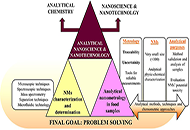 Monitoring nanomaterials in food: a critical overview, perspectives, and challengesOpen AccessReviewNanoscience and nanotechnology have experienced a dizzying development in recent years, which undoubtedly contributes to various fields of human activity such as biotechnology, engineering, medical [...] Read more.Natalia Villamayor ... Ángel RíosPublished: April 27, 2023 Explor Foods Foodomics. 2023;1:43–61
Monitoring nanomaterials in food: a critical overview, perspectives, and challengesOpen AccessReviewNanoscience and nanotechnology have experienced a dizzying development in recent years, which undoubtedly contributes to various fields of human activity such as biotechnology, engineering, medical [...] Read more.Natalia Villamayor ... Ángel RíosPublished: April 27, 2023 Explor Foods Foodomics. 2023;1:43–61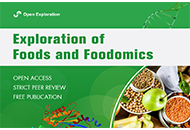 Green subcritical water extraction of Mentha x rotundifolia leaves collected in different annuitiesOpen AccessOriginal ArticleAim: In this work, the development for the first time of a green and efficient method to obtain bioactive extracts from Mentha x rotundifolia leaves has been investigated. Methods: The effi [...] Read more.María Jesús García-Sarrió ... María Luz SanzPublished: April 27, 2023 Explor Foods Foodomics. 2023;1:32–42
Green subcritical water extraction of Mentha x rotundifolia leaves collected in different annuitiesOpen AccessOriginal ArticleAim: In this work, the development for the first time of a green and efficient method to obtain bioactive extracts from Mentha x rotundifolia leaves has been investigated. Methods: The effi [...] Read more.María Jesús García-Sarrió ... María Luz SanzPublished: April 27, 2023 Explor Foods Foodomics. 2023;1:32–42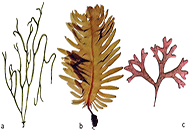 Atlantic algae as food and their extractsOpen AccessReviewAmong the species of the rich algological flora of the North Atlantic, some can be used for direct consumption in human food, although few are currently cultivated on a large scale and/or marketed f [...] Read more.Leonel PereiraPublished: April 27, 2023 Explor Foods Foodomics. 2023;1:15–31
Atlantic algae as food and their extractsOpen AccessReviewAmong the species of the rich algological flora of the North Atlantic, some can be used for direct consumption in human food, although few are currently cultivated on a large scale and/or marketed f [...] Read more.Leonel PereiraPublished: April 27, 2023 Explor Foods Foodomics. 2023;1:15–31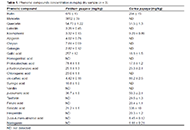 Phytochemical screening of Psidium guajava and Carica papaya leaves aqueous extracts cultivated in Greece and their potential as health boostersOpen AccessOriginal ArticleAim: The scope of the present study was to investigate the phytochemical profile of Psidium guajava and Carica papaya leaves aqueous extracts, from plants cultivated on Crete island in Greece. [...] Read more.Dimitrios D. Ntakoulas ... Charalampos ProestosPublished: April 26, 2023 Explor Foods Foodomics. 2023;1:5–14
Phytochemical screening of Psidium guajava and Carica papaya leaves aqueous extracts cultivated in Greece and their potential as health boostersOpen AccessOriginal ArticleAim: The scope of the present study was to investigate the phytochemical profile of Psidium guajava and Carica papaya leaves aqueous extracts, from plants cultivated on Crete island in Greece. [...] Read more.Dimitrios D. Ntakoulas ... Charalampos ProestosPublished: April 26, 2023 Explor Foods Foodomics. 2023;1:5–14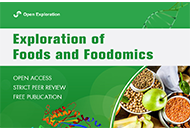 Exploration of Foods and Foodomics: a new adventureOpen AccessEditorialAlejandro Cifuentes, Elena IbáñezPublished: March 01, 2023 Explor Foods Foodomics. 2023;1:1–4
Exploration of Foods and Foodomics: a new adventureOpen AccessEditorialAlejandro Cifuentes, Elena IbáñezPublished: March 01, 2023 Explor Foods Foodomics. 2023;1:1–4